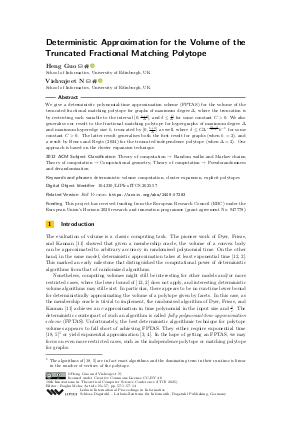Deterministic Approximation for the Volume of the Truncated Fractional Matching Polytope
Authors
Heng Guo  ,
Vishvajeet N
,
Vishvajeet N 
-
Part of:
Volume:
16th Innovations in Theoretical Computer Science Conference (ITCS 2025)
Part of: Series: Leibniz International Proceedings in Informatics (LIPIcs)
Part of: Conference: Innovations in Theoretical Computer Science Conference (ITCS) - License:
 Creative Commons Attribution 4.0 International license
Creative Commons Attribution 4.0 International license
- Publication Date: 2025-02-11
File

PDF
LIPIcs.ITCS.2025.57.pdf
- Filesize: 0.72 MB
- 14 pages
Document Identifiers
Related Versions
- Full Version https://arxiv.org/abs/2409.07283
Subject Classification
ACM Subject Classification
- Theory of computation → Random walks and Markov chains
- Theory of computation → Computational geometry
- Theory of computation → Pseudorandomness and derandomization
Keywords
- deterministic volume computation
- cluster expansion
- explicit polytopes
Metrics
- Access Statistics
-
Total Accesses (updated on a weekly basis)
0PDF Downloads0Metadata Views
Abstract
We give a deterministic polynomial-time approximation scheme (FPTAS) for the volume of the truncated fractional matching polytope for graphs of maximum degree Δ, where the truncation is by restricting each variable to the interval [0,(1+δ)/Δ], and δ ≤ C/Δ for some constant C > 0. We also generalise our result to the fractional matching polytope for hypergraphs of maximum degree Δ and maximum hyperedge size k, truncated by [0,(1+δ)/Δ] as well, where δ ≤ CΔ^{-(2k-3)/(k-1)}k^{-1} for some constant C > 0. The latter result generalises both the first result for graphs (when k = 2), and a result by Bencs and Regts (2024) for the truncated independence polytope (when Δ = 2). Our approach is based on the cluster expansion technique.
Cite As Get BibTex
Heng Guo and Vishvajeet N. Deterministic Approximation for the Volume of the Truncated Fractional Matching Polytope. In 16th Innovations in Theoretical Computer Science Conference (ITCS 2025). Leibniz International Proceedings in Informatics (LIPIcs), Volume 325, pp. 57:1-57:14, Schloss Dagstuhl – Leibniz-Zentrum für Informatik (2025)
https://doi.org/10.4230/LIPIcs.ITCS.2025.57
BibTex
@InProceedings{guo_et_al:LIPIcs.ITCS.2025.57,
author = {Guo, Heng and N, Vishvajeet},
title = {{Deterministic Approximation for the Volume of the Truncated Fractional Matching Polytope}},
booktitle = {16th Innovations in Theoretical Computer Science Conference (ITCS 2025)},
pages = {57:1--57:14},
series = {Leibniz International Proceedings in Informatics (LIPIcs)},
ISBN = {978-3-95977-361-4},
ISSN = {1868-8969},
year = {2025},
volume = {325},
editor = {Meka, Raghu},
publisher = {Schloss Dagstuhl -- Leibniz-Zentrum f{\"u}r Informatik},
address = {Dagstuhl, Germany},
URL = {https://drops.dagstuhl.de/entities/document/10.4230/LIPIcs.ITCS.2025.57},
URN = {urn:nbn:de:0030-drops-226858},
doi = {10.4230/LIPIcs.ITCS.2025.57},
annote = {Keywords: deterministic volume computation, cluster expansion, explicit polytopes}
}
Author Details
Funding
This project has received funding from the European Research Council (ERC) under the European Union’s Horizon 2020 research and innovation programme (grant agreement No. 947778).
References
- Antar Bandyopadhyay and David Gamarnik. Counting without sampling: new algorithms for enumeration problems using statistical physics. In SODA, pages 890-899. ACM, 2006. URL: http://dl.acm.org/citation.cfm?id=1109557.1109655.
- Imre Bárány and Zoltán Füredi. Computing the volume is difficult. Discrete Comput. Geom., 2(4):319-326, 1987. URL: https://doi.org/10.1007/BF02187886.
-
Alexander Barvinok. Asymptotic estimates for the number of contingency tables, integer flows, and volumes of transportation polytopes. Int. Math. Res. Not., 2009(2):348-385, 2009.

- Alexander Barvinok and Mark Rudelson. A quick estimate for the volume of a polyhedron. arXiv, 2021. URL: https://arxiv.org/abs/2112.06322.
- Alexander I. Barvinok. Computing the volume, counting integral points, and exponential sums. Discrete Comput. Geom., 10(2):123-141, 1993. URL: https://doi.org/10.1007/BF02573970.
- Alexander I. Barvinok. Combinatorics and Complexity of Partition Functions, volume 30 of Algorithms and combinatorics. Springer, 2016. URL: https://doi.org/10.1007/978-3-319-51829-9.
- Mohsen Bayati, David Gamarnik, Dimitriy A. Katz, Chandra Nair, and Prasad Tetali. Simple deterministic approximation algorithms for counting matchings. In STOC, pages 122-127. ACM, 2007. URL: https://doi.org/10.1145/1250790.1250809.
- Ferenc Bencs and Guus Regts. Approximating the volume of a truncated relaxation of the independence polytope. arXiv, 2024. URL: https://doi.org/10.48550/arXiv.2404.08577.
- Andreas Björklund, Thore Husfeldt, Petteri Kaski, and Mikko Koivisto. Computing the Tutte polynomial in vertex-exponential time. In FOCS, pages 677-686. IEEE Computer Society, 2008. URL: https://doi.org/10.1109/FOCS.2008.40.
- Christian Borgs, Jennifer T. Chayes, Jeff Kahn, and László Lovász. Left and right convergence of graphs with bounded degree. Random Struct. Algorithms, 42(1):1-28, 2013. URL: https://doi.org/10.1002/RSA.20414.
- Martin E. Dyer, Alan M. Frieze, and Ravi Kannan. A random polynomial time algorithm for approximating the volume of convex bodies. J. ACM, 38(1):1-17, 1991. URL: https://doi.org/10.1145/102782.102783.
- György Elekes. A geometric inequality and the complexity of computing volume. Discrete Comput. Geom., 1(4):289-292, 1986. URL: https://doi.org/10.1007/BF02187701.
- David Gamarnik and Devin Smedira. Computing the volume of a restricted independent set polytope deterministically. arXiv, 2023. URL: https://doi.org/10.48550/arXiv.2312.03906.
-
Tyler Helmuth, Will Perkins, and Guus Regts. Algorithmic Pirogov-Sinai theory. Probab. Theory Related Fields, 176(3-4):851-895, 2020.

-
Matthew Jenssen. The cluster expansion in combinatorics. In Surveys in combinatorics 2024, volume 493 of London Math. Soc. Lecture Note Ser., pages 55-88. Cambridge Univ. Press, Cambridge, 2024.

- Matthew Jenssen, Peter Keevash, and Will Perkins. Algorithms for #BIS-hard problems on expander graphs. SIAM J. Comput., 49(4):681-710, 2020. URL: https://doi.org/10.1137/19M1286669.
-
Roman Kotecký and David Preiss. Cluster expansion for abstract polymer models. Comm. Math. Phys., 103(3):491-498, 1986.

-
Jim Lawrence. Polytope volume computation. Math. Comp., 57(195):259-271, 1991.

-
Nimrod Megiddo and Ramaswamy Chandrasekaran. On the ε-perturbation method for avoiding degeneracy. Oper. Res. Lett., 8(6):305-308, 1989.

- Viresh Patel and Guus Regts. Deterministic polynomial-time approximation algorithms for partition functions and graph polynomials. SIAM J. Comput., 46(6):1893-1919, 2017. URL: https://doi.org/10.1137/16M1101003.
-
William T. Tutte. A contribution to the theory of chromatic polynomials. Canad. J. Math., 6:80-91, 1954.

- Dror Weitz. Counting independent sets up to the tree threshold. In STOC, pages 140-149. ACM, 2006. URL: https://doi.org/10.1145/1132516.1132538.
-
Hassler Whitney. A logical expansion in mathematics. Bull. Amer. Math. Soc., 38(8):572-579, 1932.

